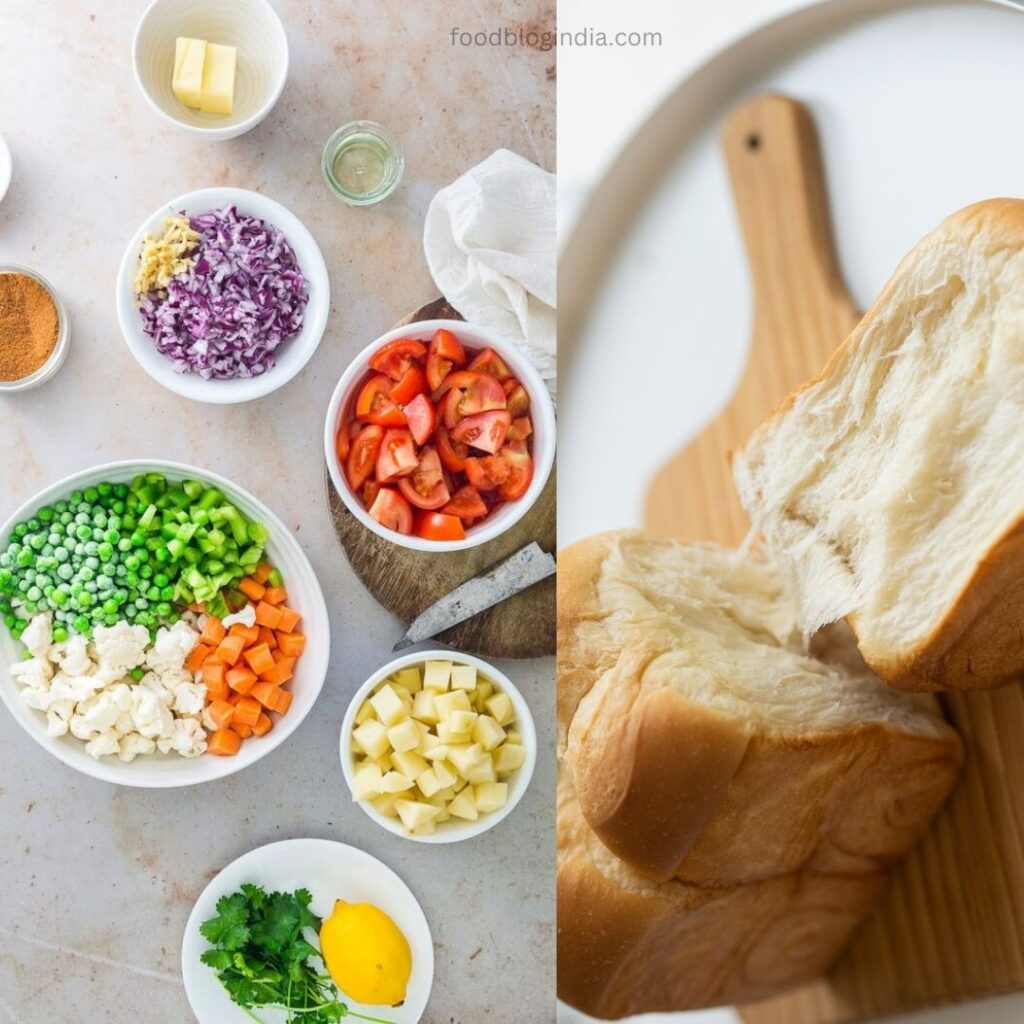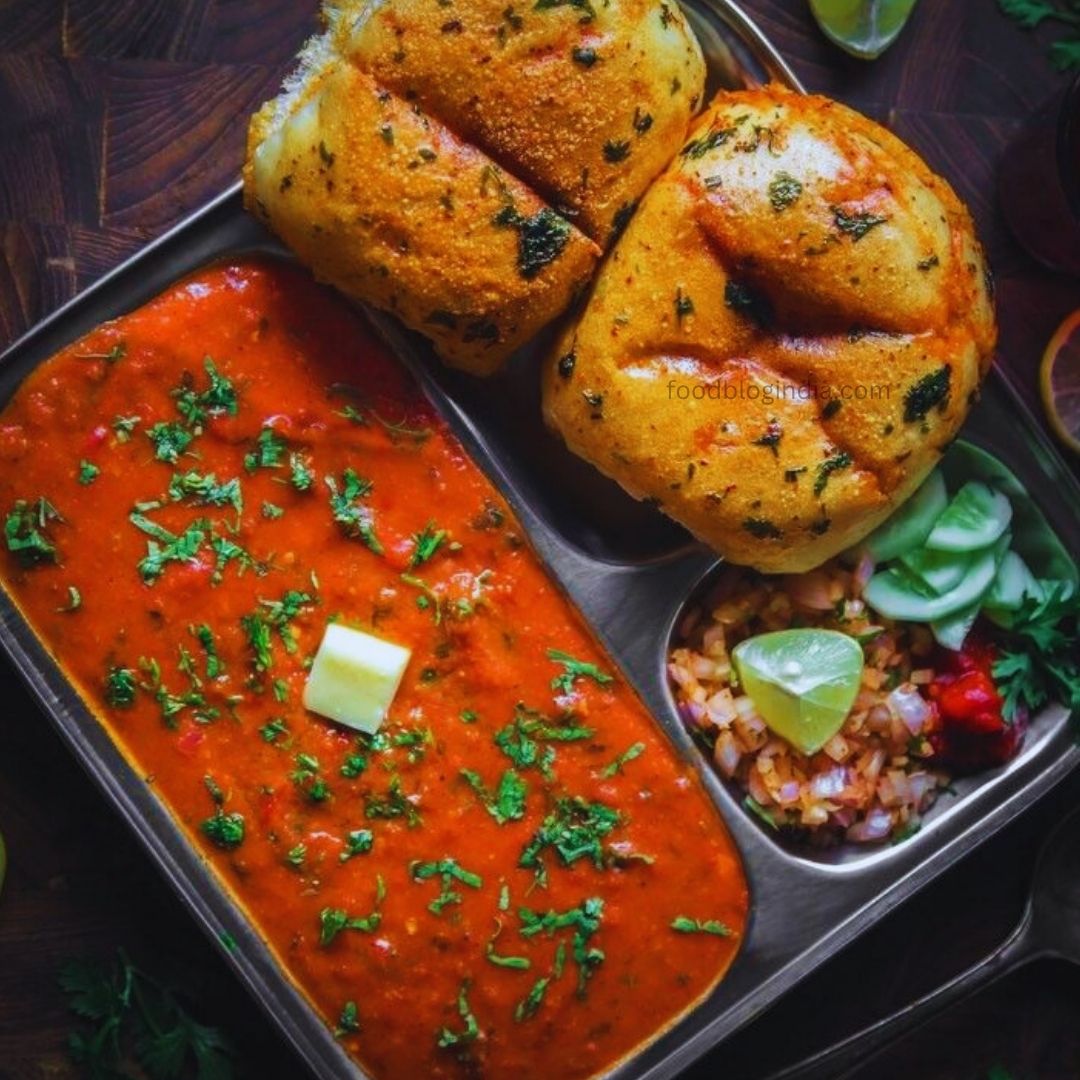Pav Bhaji, an iconic Indian street food, is a mix of mashed vegetables cooked with aromatic spices and served with buttery bread rolls (pav). This dish, which originated in Mumbai, has become a favorite throughout India and around the world, thanks to its tantalizing flavor and versatility. Pav bhaji, whether served as a quick snack or a full meal, is the epitome of comfort food. Here’s a step-by-step guide for making this delicious dish at home.

Pav Bhaji Recipe Ingredients
| Bhaji (Vegetable Mash) | Pav (Bread Rolls) |
|---|---|
| Potatoes – 4 medium-sized, boiled and peeled | Pav bread rolls – 8 (available in Indian grocery stores or use dinner rolls) |
| Cauliflower – 1 cup, finely chopped | Butter – 2 tablespoons |
| Green peas – 1/2 cup, boiled | Pav Bhaji Masala – 1/4 teaspoon (optional, for flavoring the pav) |
| Carrots – 1/2 cup, diced | |
| Capsicum (bell peppers) – 1, finely chopped | |
| Tomatoes – 4 large, finely chopped or pureed | |
| Onion – 2 medium-sized, finely chopped | |
| Ginger – 1-inch piece, grated | |
| Garlic – 5-6 cloves, minced | |
| Green chilies – 2, finely chopped | |
| Pav Bhaji Masala – 2 tablespoons (available in Indian stores) | |
| Red chili powder – 1 teaspoon | |
| Turmeric powder – 1/2 teaspoon | |
| Butter – 3 tablespoons | |
| Oil – 2 tablespoons | |
| Salt – to taste Lemon – 1, sliced Fresh coriander leaves – for garnish |

Pav Bhaji Recipe
1. Preparing the Vegetables
– Boil the potatoes, cauliflower, carrots, and green peas until soft. You can use a pressure cooker, an instant pot, or the stovetop method. After cooking, mash the vegetables lightly with a potato masher. The consistency should be coarse in order to retain some texture.
– Chopping the ingredients, Finely chop the onions, tomatoes, capsicum, green chilies, ginger, and garlic. Preparing these ahead of time will help the cooking process run more smoothly.

Bhaji Recipe
2. Making the Bhaji
– Heat the oil and butter, In a large, heavy-bottomed pan or kadai, combine 2 tablespoons oil and 1 tablespoon butter. The combination of butter and oil keeps the butter from burning while maintaining its rich flavor.
– Aromatics, Add the chopped onions and cook until translucent. Combine the minced garlic, grated ginger, and green chilies. Stir for one minute until fragrant.
– Add Tomatoes, Mix in the finely chopped or pureed tomatoes. Cook until the tomatoes are completely broken down and the oil begins to separate from the mixture. This makes the base rich and flavorful.
– Spices, Combine turmeric powder, red chili powder, and pav bhaji masala. Stir thoroughly and allow the spices to bloom for 1-2 minutes.
– Combine Vegetables, Add the mashed vegetables to the pan and stir well. Use a potato masher to further blend the mixture, resulting in a smooth but slightly chunky texture.
– Adjust the consistency by gradually adding water (about 1 cup) until the mixture is semi-thick. Stir well and cook the bhaji on low heat for 10-15 minutes to allow the flavors to meld. Stir occasionally to avoid sticking.
– Finishing touches, Mix in 2 tablespoons butter and a handful of chopped coriander leaves. Mix well and season to taste.

Pav Recipe
3. Preparing the Pav
– Slice the Pav, Cut the pav rolls horizontally, leaving one side attached for easy handling.
– Butter the Pav, Heat a tawa (griddle) and add plenty of butter. Sprinkle a pinch of pav bhaji masala over the butter to add flavor.
– Toast the Pav, Place the pav on the tawa and cook until golden and crispy on both sides. Take care not to burn them.

Serving the Pav Bhaji
– Plating, Serve the hot bhaji on a deep plate or bowl. Finish with a dollop of butter, a sprinkle of chopped coriander leaves, and a wedge of lemon.
– To accompany the pav, arrange the toasted pav rolls around the bhaji. For those who prefer a tangier crunch, serve with extra lemon wedges and chopped onions.
– Optional Additions, For more variety, serve the dish with cucumber slices, pickles, or green chutney.

Cultural Significance and Popularity
Pav Bhaji has a special place in the hearts of food enthusiasts across India. Originally created as a quick lunch option for Mumbai mill workers in the nineteenth century, it has evolved into a dish that crosses social and cultural boundaries. Pav bhaji is now served everywhere, from street stalls to high-end restaurants. Its adaptability allows for countless customizations, making it suitable for a wide range of palates.
The contrasting textures and flavors, soft buttery pav dipped in spicy, tangy, and rich bhaji, create a sensory experience that few can resist. Many Indians associate the dish with nostalgia, recalling family gatherings, festive occasions, and late-night street food adventures.

Pav Bhaji Conclusion
Pav Bhaji is more than just a meal; it’s an experience that combines different flavors and creates a sense of comfort. By following this recipe, you can bring the magic of Mumbai’s streets into your own kitchen. Pav bhaji is a crowd-pleaser, whether you’re hosting a party or enjoying it on your own. So gather your ingredients, turn up the heat, and enter the delightful world of this Indian classic.


I’m still learning from you, while I’m trying to achieve my goals. I absolutely enjoy reading all that is posted on your blog.Keep the stories coming. I liked it!